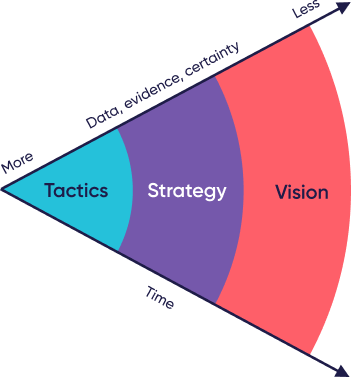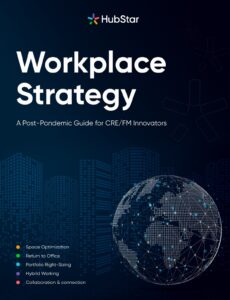
How to nail your workplace strategy
As a workplace leader, your end goal is to give employees exactly what they need to do their best work and live their best lives.
But making the ideal future of work a reality is easier said than done. There are some pretty hefty roadblocks in the way – the primary one being that the physical workplace hasn’t kept pace with what people want and need out of the office.
It’s become glaringly obvious that today’s work environments aren’t helping employees or leadership teams.
85% of employees are not engaged or actively disengaged, 60% would quit if they were forced back into the office full time and only 12% of leadership teams think their people are productive.
How can you create a brighter future of work? A future in whichpeople are engaged wherever they’re working, actually want to come into the office, and aren’t subjected to unfounded doubts about their productivity?
A workplace strategy gets you there.
Here’s how you can figure out what the future of work should look like at your company and how to create a workplace strategy to help you achieve it.
What is a workplace strategy?
A workplace strategy is a plan that aligns work environments with employee work patterns and preferences. A workplace strategy helps employees perform their best, reduces costs and helps the organization achieve its goals.
Why do you need a workplace strategy?
It’s tough to strike the perfect balance between ticking off your business goals and making sure your company is an epic place to work. A workplace strategy helps you walk that line without toppling over by mobilizing the resources you need to reduce costs, exceed employee expectations and hit commercial targets.
After people, real estate weighs heaviest on the P&L. Without a workplace strategy, underutilized space hemorrhages budget and increases carbon emissions.
Employees expect a sense of purpose, autonomy, connection and consistent learning opportunities, regardless of where they’re working. Without a workplace strategy, employees’ won’t have these expectations met, let alone have compelling reason to come into the office.
Amongst massive socioeconomic uncertainty, the consequences of falling short on commercial targets are an existential threat to every company. Without a workplace strategy, businesses don’t have the tools and resources they need to do more with less.
A workplace strategy should be future-proof and easily adaptable as your company, employees and the world at large change.
That’s why we’ll be looking at creating a strategy in three distinct parts – vision, strategy and tactics.
How to shape the vision and desired outcome of your workplace strategy
Everyone loves a good story.
And when it comes to new ways of working, everyone needs a story, too. That’s because a compelling vision of the future makes change much easier and more palatable. Your company’s vision for the workplace is the starting point for creating your strategy.
Solid goals and priorities are the second step – they’ll help you keep your workplace strategy chugging along in the medium to long term, rather than fizzling out
Here are some framing questions to create your guiding vision and goals.
- What’s your leadership team’s vision for the future of work? How can your workplace reflect this and inspire your employees?
- How strong is your culture? How can your workplace maintain and strengthen a sense of belonging that drives innovation and employee wellbeing?
- What’s the highest priority business goal? Cutting costs or attracting top talent are a couple of the most common examples. How can your workplace impact this goal?
Tactics to create your workplace strategy:
After you’ve shaped your vision and the goals you’ll work towards, it’s time to take action. Here are four tactics to make your workplace strategy a reality.
1. Track employee work habits and preferences.
When it comes to work patterns, the big five are:
- Fully remote
- Fully in-office
- Trust-based hybrid (employees decide when and how frequently they’ll come into the office)
- Expectation-based hybrid (for example, two days in the office)
- Schedule-based hybrid (for example, Tuesdays and Wednesdays in the office)
Related: What is hybrid work and why is it important?
Measuring the actual, rather than estimated, usage of workplaces gives you an understanding of past, present and future occupancy levels, so you can make data-driven decisions that align your future work environment with how employees use it. By tracking employee work habits and preferences and building them into your workplace strategy, it will quickly become apparent whether your business needs to keep, drop or optimize buildings, floors and zones. If you’re dropping corporate real estate from your portfolio because employees aren’t using it, this is where you’ll start to see cost savings.
Download the full Workplace Strategy guide to learn more about measuring actual occupancy levels.
2. Measure usage of space and quantify demand.
This is a much more granular measurement of how employees are using the physical work environment – think desks, kitchens and meeting rooms instead of buildings and floors. This is also where we get into understanding what employees use spaces for, rather than just whether they’re using them or not.
Quantifying demand will shape whether your workplace strategy and space planning are more geared towards collaboration or emphasize individual productivity. By getting granular with space utilization, you’ll understand how to configure workspaces to suit the way employees want to work, and either drop or repurpose what isn’t being used – without the costly experiments like adding a new kitchen that no one ever ventures into.
3. Assess how space utilization impacts employee experience.
A ghost town of an office on Mondays and Fridays versus a jam packed one the rest of the week might be the norm for most of us. Unfortunately, this is a norm that degrades the employee experience and increases waste.
Peaks and troughs in office utilization create volatility that make offices too empty or too crowded and prevent you from optimizing your workplaces and spaces. Assessing peaks and troughs will help you create a workplace strategy that makes sure everyone is using the space in ways that keep the employee experience stellar while keeping costs as low as possible.
Pro-tip: Intelligent Scheduling software can help you influence occupancy levels in your workspaces, so they’re never too crowded nor too empty.
4. Find out what compels employees to come into the office.
And no, company expectations aren’t a compelling reason.
What can your workplace offer that employees can’t get working remotely?
For the majority of us, that special something is connection. 73% of employees would head into the office if they knew their direct team members would be there, and 74% would do the same if they knew their work besties would be in on the same day.
Take it one step further and ask yourself how your workspaces can be configured and designed to give every employee easy access to the number one thing they want from the office. This tactic is absolutely key to creating a workplace strategy that actually, well, works, because it articulates to your entire organization why people should bother turning up at all. Further down the line, it will make sure employees are using spaces in manageable and scalable ways.
—–
As you shape your vision, strategy and tactics, chances are you’ll run into one of the three most common pitfalls of creating a workplace strategy.
Download the full Workplace Strategy guide for CRE/FM Innovators to find out what they are, and what steps you can take to overcome them.




